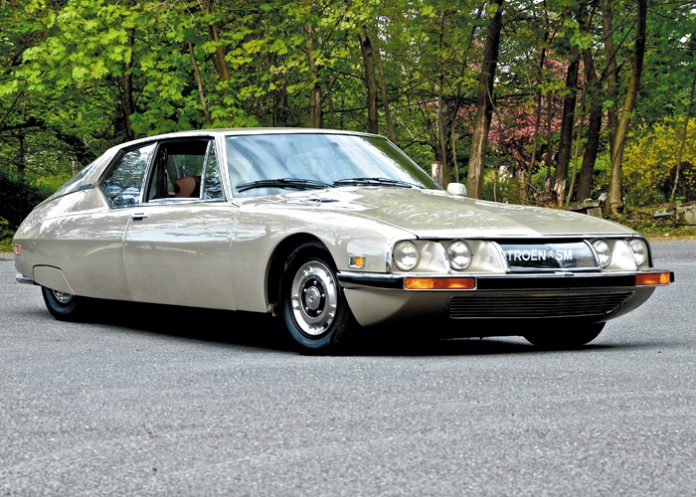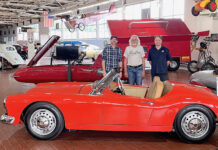By Jay Hirsch
Of the many automakers since cars were first made, Citroën was one that proved that cleverly-designed, avant-garde cars could sell in good numbers to the general public. From Citroën’s elegant front wheel-drive Traction Avant (French for “front wheel drive”), made from 1934 to 1957, to the simplicity of the 2 CV (deux chevaux), and the futuristic 1955 Citroën DS that replaced the Traction Avant, Citroën has always had a reputation for incredible, creative engineering coupled with great design that is distinctly French in character. The 1934 Traction Avant was the world’s first mass-produced uni-bodied front-wheel-drive car
In 1968 Citroën bought the Italian car company Maserati with an eye toward producing a powerful sports-type touring car.The result of the merger was the new 1970 Citroën SM seen here. The SM was a two-door touring version of the DS but with the potent Maserati V-6 engine.
The SM had the hydropneumatic suspension of the DS. It is a self-leveling suspension that maintains a constant riding height above the road regardless of the weight of the passengers and cargo. It makes for the smoothest of rides and excellent cornering, absorbing road irregularities without disturbing passengers. The ride was more like “riding on a cloud” than a sports-car-type ride. Which may have been good or not so good depending on what a driver was looking for in a touring type sports car.
The driver could also adjust the height of the car for various road conditions There was a switch on side of the driver’s seat which allowed the driver to adjust the height of the car. This height adjustability allowed for the clearing of obstacles, fording shallow, and slow-moving streams. A low height was for high-speed highway cruising, and also for changing tires. One would raise the Citroën to its maximum height, then place a stand under the frame where the tire to be changed was and then lower the car onto the stand and change the tire.
The corporate idea behind the SM was for Citroën to enter the “luxury grand touring car market.” At a price of $13,350 in 1973, “luxury” was the word.
Looking at the Citroën it appears to be wider in the front than the rear. This is not an illusion — the SM is eight inches narrower in the rear than the front of the car. On European produced SMs, the headlights were encased behind glass and turned in the direction of the front wheels. Glass-encased headlights were illegal in 1973 on cars in the United States, as well as headlights that turned in the direction of the front wheels.
The SM seen here has traveled across the U.S., from the east coast to the west coast twice, with its owner Eric Holveig. Eric fell in love with the Citroën SM the first time he saw one as a freshman in college in the early 1980s. He did not know what kind of car it was or the year. At the time he thought it was a “new car.’ A few weeks after seeing the car in the college town, he saw the car again and asked the owner if he could “talk for a minute,” garnering all the information he could about the SM. Eric said to himself, “One day I will own one.”
In 2005 “that some day happened,” changing Eric’s life forever. Reading a local paper he saw an ad for a 1973 Citroën — original owner, original condition, call for more information. Eric drove the 40 miles to see the car with a friend who “knew about cars, but was not that familiar with Citroëns.” After going over the exterior of the car, and looking at the engine with “all those control valves,” Eric went for a ride.
“The seats were the most comfortable I have ever sat in on a car,” he said. “They cradle your body with just the right amount of support without being rigid or stiff.”
As for the ride, Eric was totally surprised at how level and straight the car was on any curve in the road or on turns. Eric’s mechanic friend told Eric that the only drawback might be getting replacement parts and finding someone with the knowledge to work on the car, it being a front-wheel-drive with a Maserati V-6 and the hydraulic system. As Eric told me: “The fun began the second day I had the car.”
Within a week he found some Citroën owners within 100 miles of his home who put him in contact with parts sources in the United State and France.
One person who was of particular help was Phillip Caron, who lives in Connecticut and is a “Citroën DS and SM expert mechanic.” Philip was born in France and always liked the DS and SM. But by the late 1990s, as the people who worked on Citroëns retired or moved on to repair more common European cars, Phillip decided that if a “high school dropout can work on cars, so can I.” Phillip became a self-taught expert/guru on Citroëns.
Phillip told Eric if he came to his house on weekends he would “educate” Eric on the mechanics and every nuance of the SM.
Eric became so profuse at the workings of the SM that he drove the car on a cross-country extended vacation in 2008 and again in 2014 “without any problems,” while getting 22 mpg at 75 to 85 mph.
“One time in New Mexico on a completely deserted-flat-miles-forever highway,” he said, “I was doing a 125 mph for ten minutes just for the sheer fun/or teenage stupidity of it. Even my wife thought it was thrilling”
One of the “downsides” to owning the SM, according to Eric, is that aside from “car people who know the car” and give Eric a thumbs up, most people think it is a “new car” and ask who “makes it?”
“How many cars made in 1973 car can you say that about?” Eric said.
When Eric tells people it is a Citroën SM and it is a 1973, he usually has to repeat “1973” two or three times.
Citroën has been part of the PSA Peugeot Citroën group since 1976 and was founded in 1919 by French industrialist André-Gustave Citroën. •



